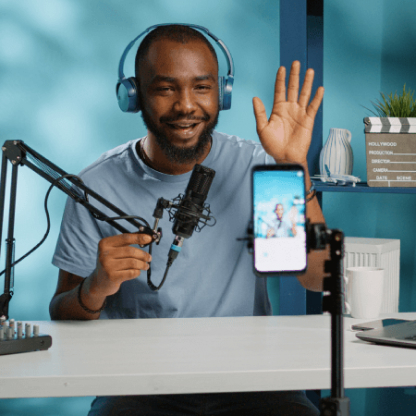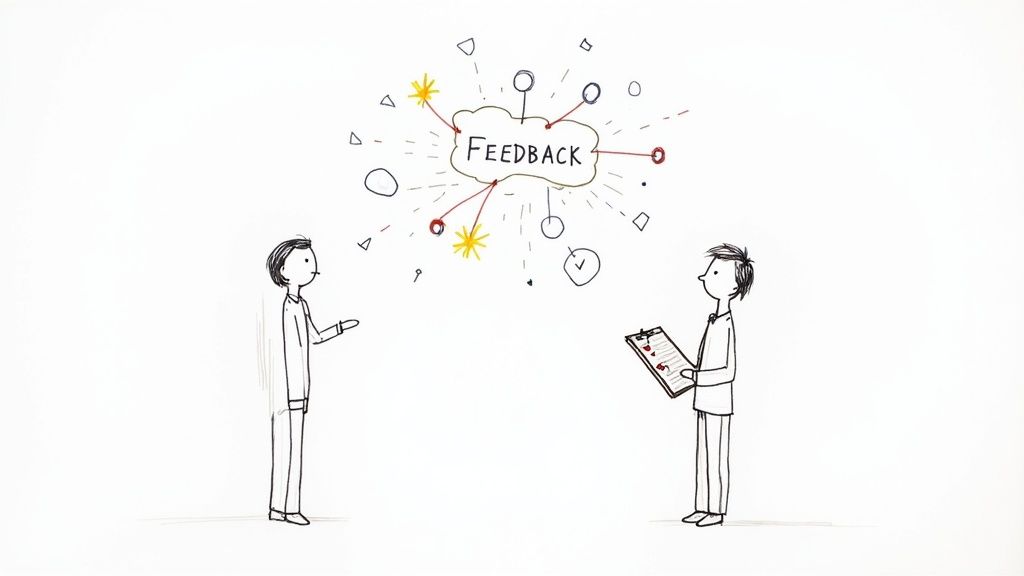A shortlist of candidates is supposed to be your handpicked group of all-stars. The final few you invite to the party after sifting through a mountain of applications. In reality? It's often just the last people standing after a soul-crushing, multi-week slog.
Think of it as the bridge between a tidal wave of resumes and a hiring process that doesn't make you want to throw your laptop out the window.
Why Your Hiring Process Is Silently Failing
Let’s be honest. Posting a role and immediately drowning in a sea of identical-looking resumes feels like running on a treadmill to nowhere. Weeks vanish into a blur of screening calls that go absolutely nowhere. Everyone ends up burned out—recruiters, hiring managers, and candidates alike.
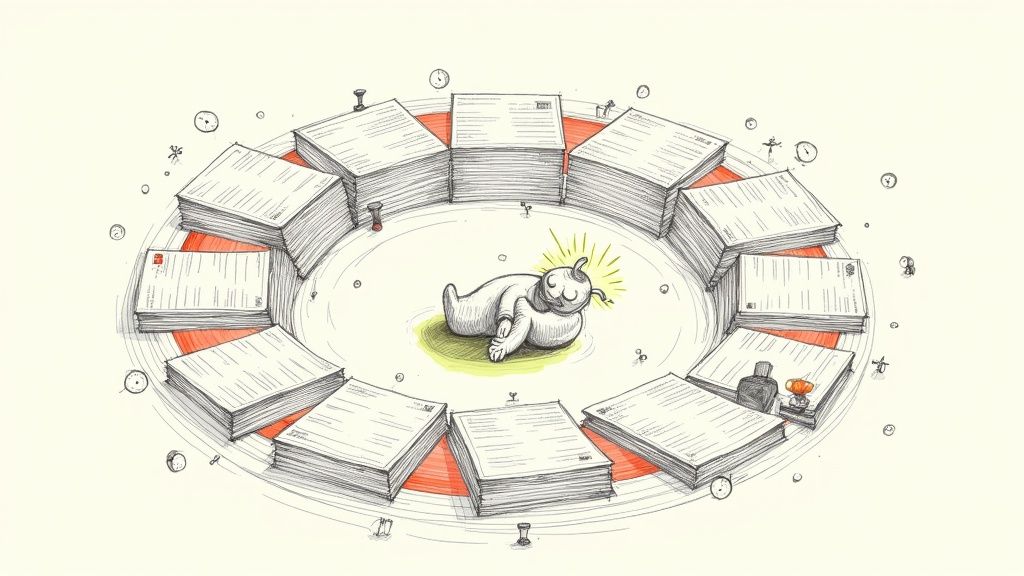
Relying on resumes and gut instinct might have worked in 1998. Today, it’s a one-way ticket to endless meetings and expensive mis-hires.
The Hidden Costs of a Bad Process
We rarely stop to calculate what a broken hiring funnel actually costs. It’s not just lost recruiter hours—it’s far more insidious than that.
- Wasted Engineering Hours: Every hour a senior dev spends on a pointless screen is an hour your product isn't moving forward.
- Team Morale Drain: A revolving door of new hires who don't work out kills confidence and breeds burnout.
- Opportunity Cost: While you’re stuck in interview limbo, your competitors are shipping features with the top talent you overlooked.
I remember sifting through 300 resumes, each promising the moon. Every single call drained more of my sanity than the last. The candidates were fine; my system was the problem.
This outdated playbook leans on flimsy signals—keywords, alma maters, and whether they used a fancy font. Before you can build a stronger shortlist, you have to face those flaws head-on. A great first step is understanding what is pre-screening to see how that initial filter can set you up for success.
It’s time to rethink the entire funnel, starting with who even earns that first look.
Old Way vs. Smart Way to Build a Shortlist
Here’s a quick and dirty comparison. See if any of this feels familiar.
| Metric | The Old Way (Resume Hell) | The Smart Way (Async Challenges) |
|---|---|---|
| Screening Time | Weeks spent on resume reviews and phone screens | Hours spent reviewing actual work demos |
| Candidate Insight | Surface-level gut checks and buzzwords | Concrete proof of skills and problem-solving |
| Bias Risk | High—based on keywords, schools, referrals | Lower—focus on performance, not pedigree |
| Hiring Speed | Months to move from application to offer | Days to shortlist and schedule deep dives |
Shifting to asynchronous challenges transforms hiring from pure guesswork into an evidence-based exercise. When you stop reading resumes and start reviewing real work, you invite candidates to prove they can do the job—and you save your team weeks of wasted effort.
That’s how you turn chaos into clarity.
Ditching Resumes for Real Skills
Let's be brutally honest: resumes are polished stories, not proof of skill. They are a terrible predictor of on-the-job performance. So why do we still start there?
What if you could flip the entire script? Instead of wading through hundreds of resumes, imagine starting with a small, paid async challenge.
Enter the $500 hello.
It’s a modest investment that instantly filters out 90% of the noise and surfaces the real talent. Suddenly, you’re not looking for a needle in a haystack; you’re choosing from a handful of solid gold needles.
Designing Effective Async Challenges
This isn't about creating a massive, unpaid project that burns goodwill. The goal is a challenge that perfectly blends relevance with respect for the candidate's time.
- Keep it real: Pick a core skill and design a task that mirrors something they’d actually do in their first month.
- Keep it brief: The challenge should take an hour, tops. Anything more is asking for a huge commitment before you've even had a real conversation.
- Keep it clear: Provide crystal-clear instructions, context, and maybe a quick example. Confusion is the enemy of a good assessment.
- Pay them for their time: The fee isn't just a payment; it's a signal. It says you're serious and you value their expertise.
This one tactic completely upends the traditional hiring funnel. You immediately focus your attention on the top 10% of applicants—the ones who not only have the skills but are also genuinely interested in the role.
For an engineer, a simple debugging task on a broken API endpoint tells you more than a dozen interviews. For a marketer, asking for a two-week content calendar outline reveals their strategic thinking in a way a resume never could.
Why Paying Candidates Matters
Paying for a small challenge might feel like an extra step, but the ROI is massive. It’s a strategic filter that does more than just test skills.
When you pay candidates, you signal that you respect their time. It’s a powerful cultural flag to plant. As a result, completion rates for paid challenges often jump above 80%, a stark contrast to the ghosting you see with unpaid tests. It also immediately weeds out the mass-appliers who aren't truly invested.
Turns out there’s more than one way to hire elite talent without mortgaging your office ping-pong table.
Want to dive deeper into structuring these assignments? Check out our guide on how to manage them effectively with a Virtual Job Tryout.
A well-paid, focused challenge is the fastest route to a shortlist of candidates who can actually deliver.
On the flip side, encouraging candidates to showcase their work through creating an online portfolio can be another great way to see their skills in action before they even apply.
Measuring the Success of Your Challenge
How do you know if your challenge is actually working? You need to track a few key metrics. Don't overcomplicate it; just focus on what matters.
- Completion Rate: How many people who start the challenge actually finish it? If it’s low, your challenge is too long or too confusing.
- Quality Score: Use a simple rubric to rate the submissions. Is the quality high, or are people just phoning it in?
- Time To Review: How long does it take your team to assess each submission? Your goal should be under 10 minutes per review.
- Interview Yield: Of the candidates who pass the challenge, how many do you advance to a final interview? This is the ultimate test of your challenge's effectiveness.
These numbers give you a clear picture of what's working and what isn't. If your yield is below 5%, it’s time to revisit the challenge prompt or your sourcing strategy.
Iterate and Improve Your Challenges
Your first challenge won't be perfect. That's okay. Treat it like any other product: gather feedback and iterate.
- Ask candidates for their thoughts on the clarity and length.
- If completion rates are too high or too low, adjust the scope of the prompt.
- If completion drops below 70%, consider if the payment is high enough to reflect the effort.
By constantly refining your challenge, you ensure that your candidate shortlist is always filled with top-tier talent. This approach transforms shortlisting from a guessing game based on paper into a true competition of skill.
Building Your First Async Hiring Funnel
Alright, enough theory. Ready to get your hands dirty and actually build this thing? Don’t worry, it’s simpler than you think. The whole point is to create a repeatable system that gives you a shortlist of highly qualified candidates before you’ve spent a single minute on a screening call.
First things first: forget that laundry list of "nice-to-haves" on your job description. What are the two or three core skills that truly define success in this role? Not five, not ten. Just the absolute non-negotiables.
Once you’ve nailed those down, you can create a challenge that tests them directly.
Crafting a Killer Challenge
Your challenge should be a bite-sized version of a real problem the new hire would actually solve. Keep it concise—something they can knock out in an hour or less. We’re testing for skill, not trying to find out who has the most free time on a Tuesday.
Here are a few battle-tested examples I’ve seen work wonders:
- For a back-end engineer: Give them a small, intentionally broken code snippet. Their task isn’t just to fix it but to explain why it was broken and how they approached the solution.
- For a growth marketer: Show them a mock landing page and give them a hypothetical $1,000 ad budget. Ask for a brief plan on how they’d spend it to maximize conversions.
- For a customer support lead: Share three genuinely tricky customer emails. Ask them to write a reply to each, balancing empathy with company policy.
The key is making the task specific and relevant. You’ll be shocked at how quickly this separates the people who can talk about the work from the people who can do the work.
This simple infographic sums up the shift perfectly—moving away from resumes and toward real-world challenges.
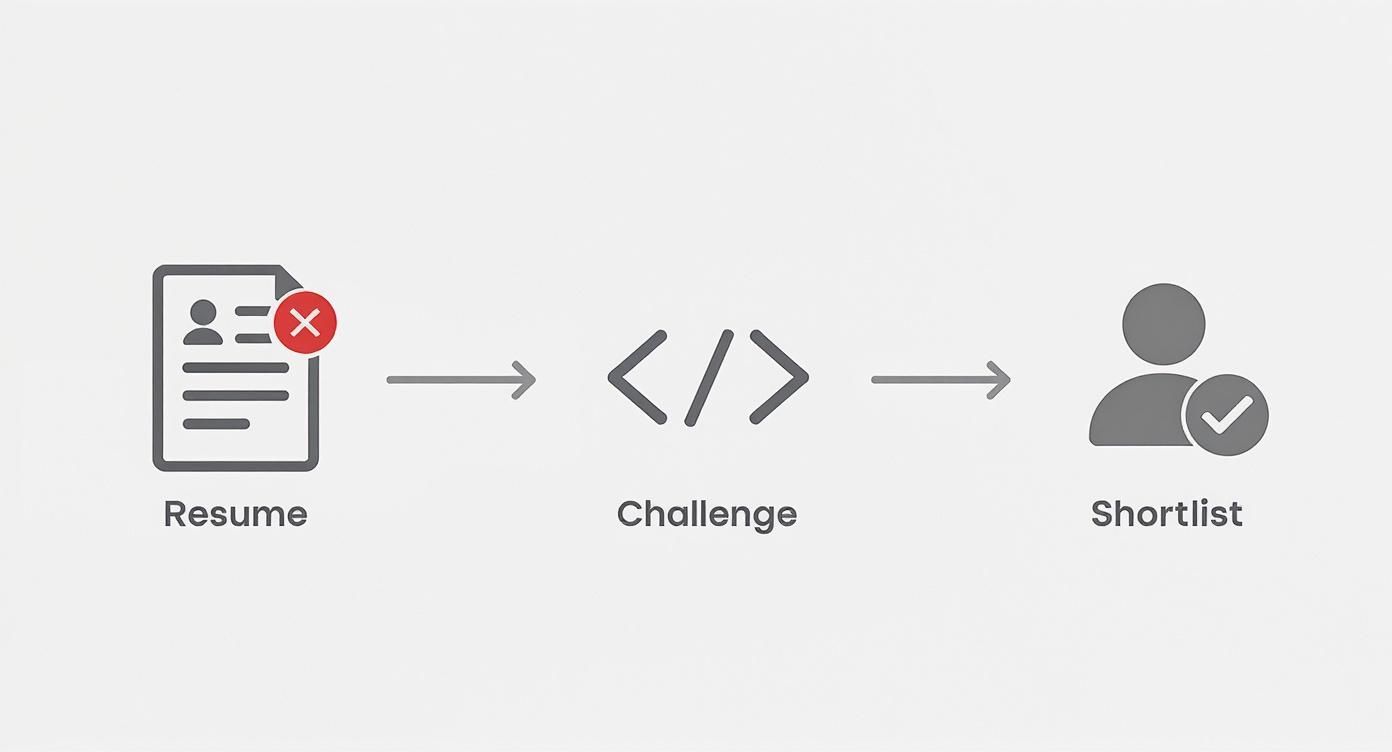
It’s all about using a practical challenge as a powerful filter, ensuring only the most capable candidates make it to the final stages.
I’ve seen teams spend weeks interviewing dozens of candidates, only to realize their final choice couldn’t perform under pressure. This process finds that out in the first 48 hours.
Now, communicating this new process is crucial. Be upfront right in the job post. Frame it as a way to respect everyone’s time and focus on what actually matters—their skills. You'll scare away the resume spammers and attract the quiet professionals who are tired of the old song and dance.
Evaluating Submissions to Finalize Your Shortlist
Alright, the submissions are rolling in. Time to evaluate. But first, a word of advice: don't fall into the trap of looking for the "perfect" answer. This isn't a high school math test; it's about spotting signals of quality, and perfection isn't one of them.
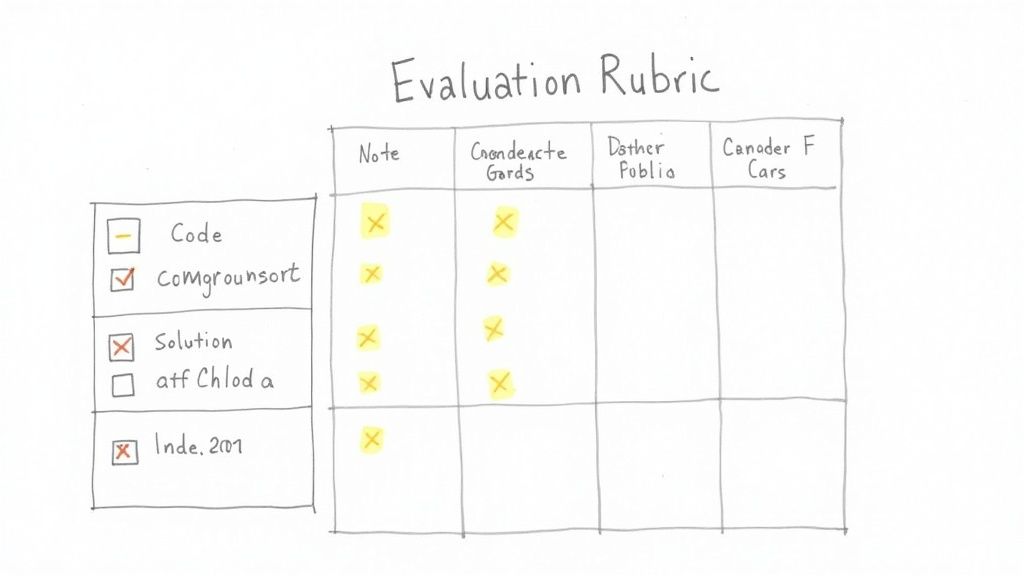
What really matters? I'm looking for clean code, clear communication, and a thoughtful problem-solving approach. A clever, one-line solution that nobody can understand is a liability, not an asset.
I’ll take a well-documented, slightly less elegant solution every single time. It shows a candidate thinks about the team, not just their own brilliance.
Creating a Simple Scoring Rubric
To keep things fair and avoid that "I just have a good feeling about this one" bias, you need a simple rubric. No, this isn't about creating a bureaucratic nightmare. It’s about being consistent.
Your rubric should be dead simple and tied directly to the skills you defined earlier. Here’s a basic structure I’ve used that works wonders:
- Clarity of Solution (1-5): Was their thought process easy to follow?
- Technical Execution (1-5): Did they solve the problem effectively without over-engineering it?
- Communication Style (1-5): Did they explain their choices clearly in the comments or a brief write-up?
This isn’t about generating a final grade. It’s a tool to guide your gut and make sure you’re comparing apples to apples. If you need a little more inspiration, check out our guide on building a great interview evaluation form.
Your job at this stage is to be ruthlessly selective. You're not trying to find reasons to say "yes." You're looking for clear signals that separate the great from the good.
Remember, the final cut is always small. By the end of your review, you should have a hyper-qualified shortlist of candidates—three to five people, max. These are the only people you actually need to get on a call with.
And as you're making those final assessments, don't forget their online presence can tell you a lot. It’s worth exploring the impact of digital footprints on job opportunities to get a fuller picture.
From Shortlist to Offer: The Final Conversation
You’ve done the heavy lifting. The async challenges are in, the evaluations are complete, and you’re looking at a shortlist of genuinely proven talent. This is the fun part.
So, what's next? The final, synchronous interview. And let's be crystal clear: this is not another interrogation.
If you find yourself asking brain teasers or "where do you see yourself in five years?" at this stage, you’ve missed the entire point. You already know they can do the work—their submission proved that. This final conversation is all about one thing: the human element.
Selling the Vision, Not Grilling for Skills
The power dynamic has officially shifted. They’re not just trying to impress you anymore; you need to impress them. Top talent always has options, and this call is as much about them evaluating your culture as it is about you making a final gut check.
Forget the technical gotchas. Your goal is to understand what drives them, see how they think about collaboration, and get them genuinely excited about your vision. This is where you close the deal.
Your questions should be designed to reveal their working style, not re-hash their resume.
- "Describe a time you disagreed with a manager's decision. What did you do?"
- "What kind of team environment brings out your best work? What drains you?"
- "When you get stuck on a really tough problem, what's your first move?"
We’re not saying we’re perfect. (Toot, toot!) Just that our method is more accurate, more often. By focusing the final interview on fit and motivation, you’re not just filling a role—you’re bringing on a partner who’s genuinely excited to build with you.
This last step isn’t about running one more test. It’s about confirming that this incredibly talented person is also someone your team will be thrilled to work alongside.
Frequently Asked Questions About Async Hiring
I get it. Changing a hiring process you’ve used for years feels risky. Let's tackle the most common questions I hear from founders—and I'll give you the same straight answers I always do.
Isn't Paying for Interview Tasks Expensive?
Seriously? Let’s run the numbers. Compare a few hundred bucks for a handful of paid tasks to the real cost of a bad hire—we’re talking 30% or more of their first-year salary, easy.
Then, factor in the dozens of engineering hours you’ll burn interviewing people who look good on paper but can't actually do the job. The math becomes pretty simple. It's one of the cheapest, highest-ROI investments you can make.
Will This Scare Away Good Candidates?
It scares away the wrong candidates—the ones shotgun-blasting their resume everywhere without any real interest in your role.
Top talent, the kind of people who are confident in their skills, actually appreciate the chance to prove themselves. Paying them is a powerful signal that you respect their time and work. Think of it as a filter, but one that screens for quality and commitment, not just keywords.
How Do I Apply This to Non-Technical Roles?
The core principle is exactly the same: replace the initial resume screen with a small, relevant task that mirrors the actual job.
- Marketing: Ask them to draft a short promotional email for a new feature.
- Sales: Have them record a two-minute video pitching your product.
- Design: Ask for a quick critique of an existing UI element on your site.
The goal isn't to get free work. It's to get a real-world sample of their skills and thinking before you commit your team's time to a full interview loop.
Ready to stop guessing and start building a shortlist of candidates based on proven skills? Async Interview gives you the tools to create, manage, and evaluate async challenges so you can hire the right person, faster. Start your free trial today.
